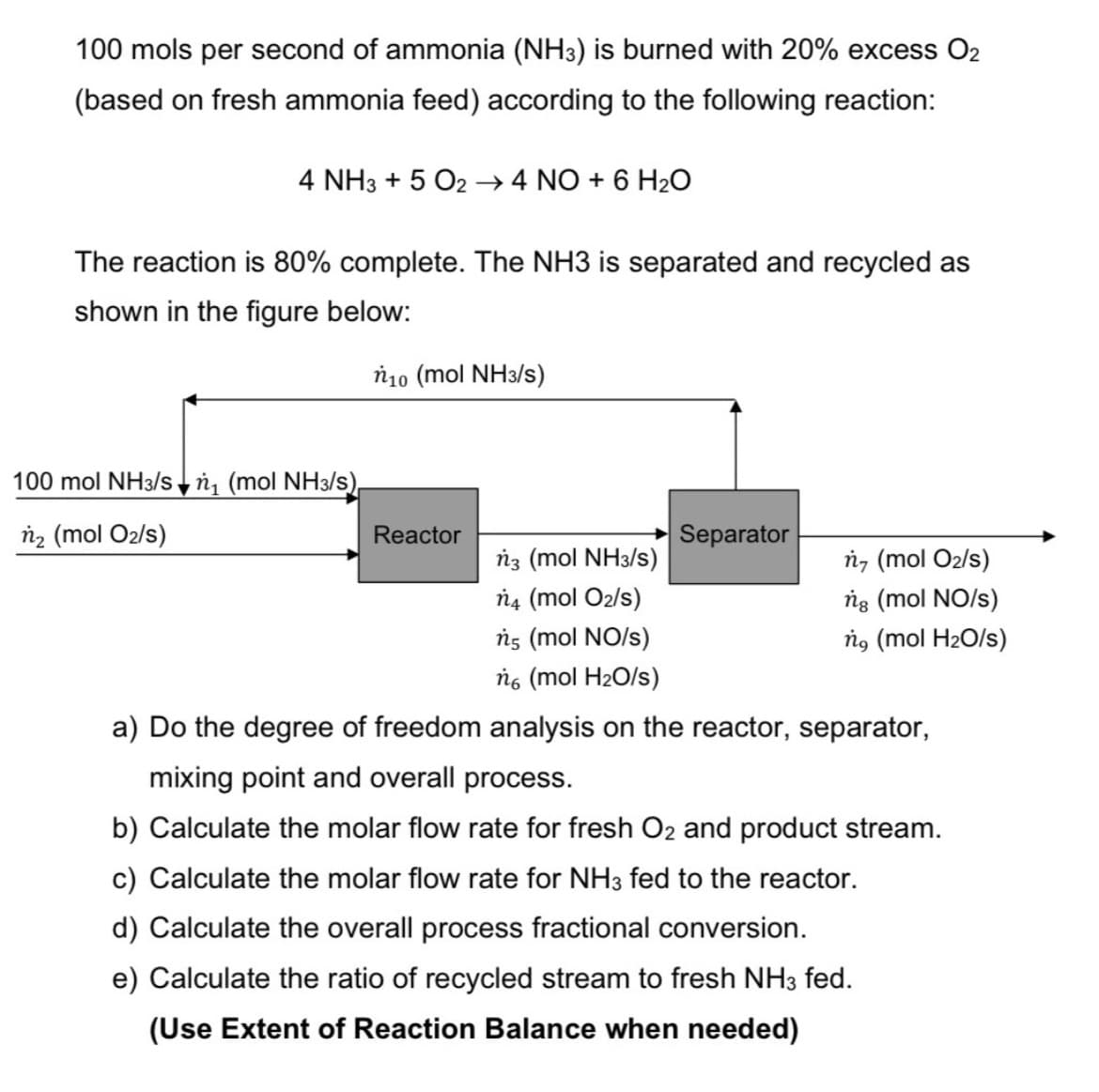100 mols per second of ammonia (NH3) is burned with 20% excess O2 based on fresh ammonia feed) according to the following reaction: 4 NH3 + 5 O2 → 4 NO + 6 H₂O The reaction is 80% complete. The NH3 is separated and recycled as shown in the figure below:
100 mols per second of ammonia (NH3) is burned with 20% excess O2 based on fresh ammonia feed) according to the following reaction: 4 NH3 + 5 O2 → 4 NO + 6 H₂O The reaction is 80% complete. The NH3 is separated and recycled as shown in the figure below:
Introduction to Chemical Engineering Thermodynamics
8th Edition
ISBN:9781259696527
Author:J.M. Smith Termodinamica en ingenieria quimica, Hendrick C Van Ness, Michael Abbott, Mark Swihart
Publisher:J.M. Smith Termodinamica en ingenieria quimica, Hendrick C Van Ness, Michael Abbott, Mark Swihart
Chapter1: Introduction
Section: Chapter Questions
Problem 1.1P
Related questions
Question
100%

Transcribed Image Text:100 mols per second of ammonia (NH3) is burned with 20% excess O₂
(based on fresh ammonia feed) according to the following reaction:
4 NH3 + 5 O2 → 4 NO + 6 H₂O
The reaction is 80% complete. The NH3 is separated and recycled as
shown in the figure below:
ń10 (mol NH3/s)
100 mol NH3/sn₁ (mol NH3/s)
n₂ (mol O₂/s)
Reactor
ń3 (mol NH3/s)
n4 (mol O₂/s)
ń5 (mol NO/s)
no (mol H₂O/s)
Separator
ń, (mol O₂/s)
ng (mol NO/s)
ng (mol H₂O/s)
a) Do the degree of freedom analysis on the reactor, separator,
mixing point and overall process.
b) Calculate the molar flow rate for fresh O₂ and product stream.
c) Calculate the molar flow rate for NH3 fed to the reactor.
d) Calculate the overall process fractional conversion.
e) Calculate the ratio of recycled stream to fresh NH3 fed.
(Use Extent of Reaction Balance when needed)
Expert Solution
This question has been solved!
Explore an expertly crafted, step-by-step solution for a thorough understanding of key concepts.
Step by step
Solved in 7 steps with 7 images

Recommended textbooks for you

Introduction to Chemical Engineering Thermodynami…
Chemical Engineering
ISBN:
9781259696527
Author:
J.M. Smith Termodinamica en ingenieria quimica, Hendrick C Van Ness, Michael Abbott, Mark Swihart
Publisher:
McGraw-Hill Education

Elementary Principles of Chemical Processes, Bind…
Chemical Engineering
ISBN:
9781118431221
Author:
Richard M. Felder, Ronald W. Rousseau, Lisa G. Bullard
Publisher:
WILEY

Elements of Chemical Reaction Engineering (5th Ed…
Chemical Engineering
ISBN:
9780133887518
Author:
H. Scott Fogler
Publisher:
Prentice Hall

Introduction to Chemical Engineering Thermodynami…
Chemical Engineering
ISBN:
9781259696527
Author:
J.M. Smith Termodinamica en ingenieria quimica, Hendrick C Van Ness, Michael Abbott, Mark Swihart
Publisher:
McGraw-Hill Education

Elementary Principles of Chemical Processes, Bind…
Chemical Engineering
ISBN:
9781118431221
Author:
Richard M. Felder, Ronald W. Rousseau, Lisa G. Bullard
Publisher:
WILEY

Elements of Chemical Reaction Engineering (5th Ed…
Chemical Engineering
ISBN:
9780133887518
Author:
H. Scott Fogler
Publisher:
Prentice Hall


Industrial Plastics: Theory and Applications
Chemical Engineering
ISBN:
9781285061238
Author:
Lokensgard, Erik
Publisher:
Delmar Cengage Learning

Unit Operations of Chemical Engineering
Chemical Engineering
ISBN:
9780072848236
Author:
Warren McCabe, Julian C. Smith, Peter Harriott
Publisher:
McGraw-Hill Companies, The